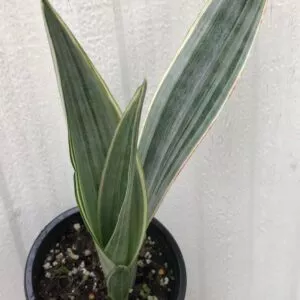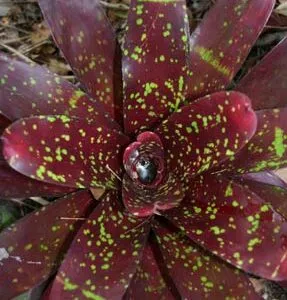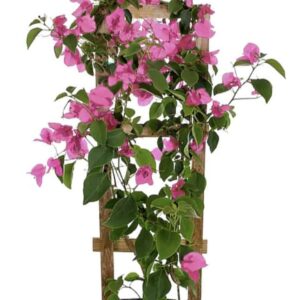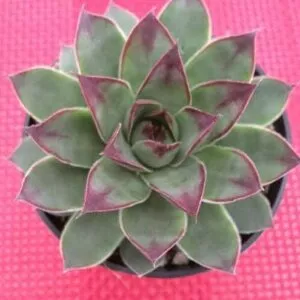No products in the cart.
Table of Contents
What a beautiful name the Fairy Fan Flower has! And look at those gorgeous blooms, they are just breathtaking. I know you agree. This outdoor plant even looks excellent when grown in hanging baskets.
You’ll normally see the Scaevola plants growing in window boxes right through to the garden, making it a versatile yet heat-tolerant plant to have. So, to make sure your fan flowers keep thriving, we will share some helpful care tips through this article.
Exciting Facts About Fan Flowers
The fan flower belongs to the genus Scaevola, with hundreds of species belonging to the Goodeniaceae family. Between 17730 to 1858, Robert Brown named the fan flower the Scaevola aemula, after Gaius Mucius, a Roman soldier.
The brave soldier demonstrated his bravery by burning off his right hand, according to the story. Thus the inspired name from Latin means left-handed with flowers shaped like half-moons. This indoor plant is native to Australia, growing in coastal districts on dunes or in a dry forest and flourishing in sandy soils.
You can find different cultivars blooming in warmer climates. The buds appear on stems with a fan shape. The plant you will see has soft pink flowers, blue flowers, white and mauve. In contrast, the center of the bloom can be yellow or white.
The plant is an evergreen with a spreading nature growing up to 12 inches tall. But it is a short-lived perennial that grows up to two years but is worth having with its rewarding blooms.
Scaevola Plant Care
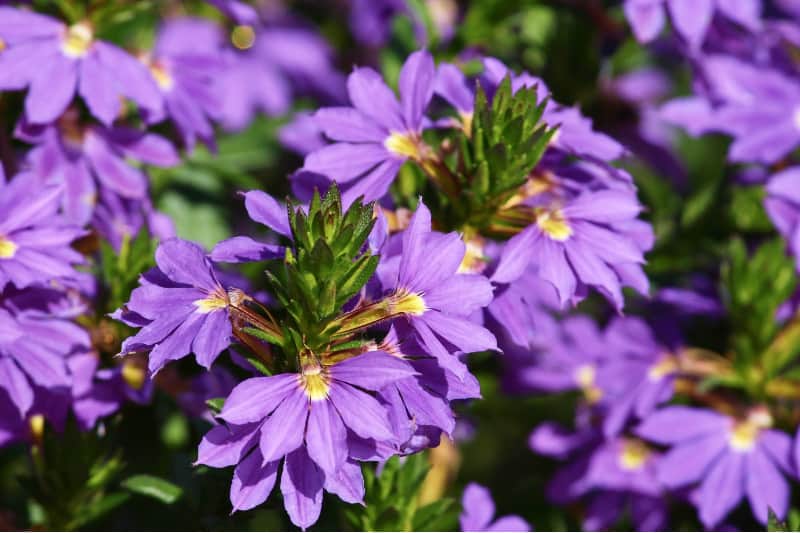
Fan flower is easy to care for. They thrive in hot climates. Whether you grow them in hanging baskets, window boxes, or in the garden, they’ll be just fine.
Neither are they big feeders or in need of a lot of pinching. So, enjoy taking care of this low-maintenance vegetation to brighten your yard or living space.

Best Potting Mix to Display The Soft Pink Flowers
It helps to have a proper soil composition for Scaevola aemula. Aside from fertility, proper drainage plays an important part.
You can grow your common blue Australian native plant in sandy loam ground. Whether grown in a container or a garden, the same rules apply.
Provide your plants with an airy potting mix coupled with a crumbled texture. If you use clayey loam soil, you can apply some compost like peat moss with pine chips mulch to help retain moisture. The crucial thing is that your plant needs to drain freely to prevent root rot as they do not tolerate soggy conditions.
Alternatively, you can invest in a general-purpose potting mix as long as it has good drainage.
In stock In stock In stock In stock (can be backordered)
$15.95
Sold By:
SunSoul Plants
$20.95Sansevieria Bantel’s Sensation in 4″ pot, ships in pot
Only 1 available and it’s in 1 people’s basket Rated 4.87 out of 5 based on 98 customer ratings01
Sold By:
SunSoul Plants
$13.99
Sold By:
BubbleBlooms
Variegated Hoya Kerrii Heart / Sweetheart Plant / Mothers day plant / Hoya Plant / Heart Shaped Succulent / Heart Hoya / Live Plant Rare
Rated 4.81 out of 5 based on 279 customer ratings01
Sold By:
BubbleBlooms
$12.99
Sold By:
BubbleBlooms
Silver Squill Leopard Plant, Ledebouria socialis, 4 inch
Rated 4.81 out of 5 based on 279 customer ratings00
Sold By:
BubbleBlooms
Free Shipping
$21.99
Sold By:
Gar-Zen Botanical Design
Bromeliad Jack of Diamonds Neoregelia Ships Free
Only 9 available and it’s in 1 people’s basket Rated 4.86 out of 5 based on 49 customer ratings00
Sold By:
Gar-Zen Botanical Design
Ideal Lighting for Scaevola Care
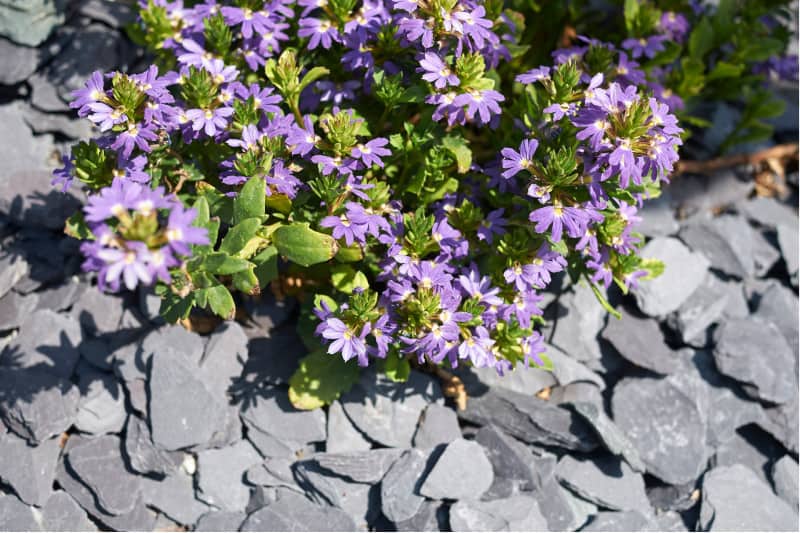
For best performance, you can grow your plant in mixed containers standing in partial shade to full sun. If you place your flower in dappled partial sun in desert areas, they remain vibrant.
Thus, the best place is a spot with at least six hours of full sun. But if you grow your plant in the partial shade, it will not flower as vibrantly as you want.
The fantastic thing is this tender perennial can grow in garden beds to tolerate dappled partial sun and is fairly drought tolerant.
Watering Needs to Grow Scaevola
While you may think the trailing Scaevola is a xeriscape plant because they prefer growing on the dry side, they are not. The outdoor plant thrives in coastal gardens with some drought tolerance but still needs watering.
We recommend checking the soil’s surface to see if it is dry with signs of wilting and watering them moderately but regularly. The fantastic thing is that the Scaevola perennial enjoys dog days and works well in low water gardens.
Temperature & Humidity Conditions

Plant Scaevola in warm-hot weather conditions with temperatures between 70°F and 85°F for them to be at their happiest. But if the heat is scorching, they can tolerate it as well.
If temperatures drop below 60°F, the flowering can slow down or stop altogether. One thing that your Scaevola plants love is high humidity. Hence, you can grow them in cooler landscapes, but flowering does become delayed.
Feeding Your Tender Perennial
As your trailing annuals are Australian natives, they need light feeding during the growing season to perk them up.
You can use a fertilizer high in nitrogen but low in phosphorus. The reason is that phosphorus can cause discoloration in the blooms and foliage. You can apply a feed once a month.
In stock In stock (can be backordered) In stock In stock
$65.00
Sold By:
Via Citrus
$75.00Meyer Lemon Citrus – Indoor/Outdoor Citrus
Only 93 available and it’s in 5 people’s basket Rated 4.92 out of 5 based on 237 customer ratings76
Sold By:
Via Citrus
$29.99
Sold By:
Rooted & Grounded Nursery
Light Pink Live Plant Bougainvillea Vine 6″ Pot Trellis
Sold By:
Rooted & Grounded Nursery
$9.99
Sold By:
Succulent Oasis
Medium Succulent Plant – Hen’s and Chicks Sempervivum Tectorum
Only 17 available and it’s in 4 people’s basket Rated 4.84 out of 5 based on 352 customer ratings02
Sold By:
Succulent Oasis
$12.95
Sold By:
SunSoul Plants
$22.95Philodendron hederaceum ‘Lemon Lime’ plant in 3″ pot, Heartleaf Philodendron
Only 2 available and it’s in 1 people’s basket Rated 4.87 out of 5 based on 98 customer ratings00
Sold By:
SunSoul Plants
Propagation of Scaevola Fairy Blue
The best way to propagate your Scaevola flower is through stem cuttings in late summer for overwintering. The important thing is to take your cutting from a stem without blooms. Here is a detailed guide on how you can do this:
- Just below a leaf node, make a 45°angle cut using a sterilized knife. You can cut up to a six-inch stem providing.
- Remove any leaves at the bottom, dip that end into a rooting hormone, and tap off any excess powder.
- Get a well-draining pot and fill it with soil mixed with perlite and peat moss.
- Take the pencil back end and press a hole for your cutting. Next, position the node below the ground and fill it with soil around the base.
- You can do this with a few stem cuttings inches apart.
- Water them well and place the container outdoors in a sunny spot. Remember to keep the ground moist but not soggy.
- Check back on your cuttings to see if it spreads roots one month after placing them in the ground. Then, you can gently tug at the stem to see if it has rooted. Or look for new growth, and once it develops several roots up to two inches long, you can transplant them.
- When transplanting into new containers or the garden, place them in a sunny place and water them well with fertilizer.
Growing Zone
You can comfortably grow your fan flower Scaevola aemula in hardiness zones ten to eleven. Still, the hardiness of growing your Scaevola blue fan can vary in these regions.
Your flowers can handle it when temperatures dip with light frost but will die back with moderate frost or if it is below freezing temperatures like in zone nine.
Potting and Pruning
For container-grown Scaevola plants, lightweight potting soil works well. Yet, you will not need to repot them as their lifecycle ends before needing transplanting.
If you want your blue flowers to grow thicker, you can pinch back the growth. Yet, you will also need to do some hard pruning to help produce new shoots when they become stringy.
Scaevola Companion Plants
Salvia, Sage

The fantastic thing about the Salvia is that it works well grown with your Scaevola varieties as it also loves a dry garden growing as an annual. The foliage attracts hummingbirds and other pollinating insects such as bees and has red or purple flowers.
But this vegetation does not enjoy cold weather and is best to plant after the last frost.
Gerbera Daisy
![]()
You will get large flowers with a sturdy stem that lasts for weeks placed with some white flowers of your Scaevola in a vase. It is another tender perennial that lasts through winter in warmer parts from nine to eleven. You can grow them as an annual in other parts of the country.
Geranium

Yes, it is a garden favorite suitable to grow in containers, beds, or borders with your Scaevola. The foliage flourishes in warm weather and dry conditions ranging in bloom shades.
Scaevola Diseases & Pests
A blue Scaevola plant in your garden will surely attract hummingbirds and some other insects like thrips in lengthy droughts. You may also find them infested with mealybugs but you can treat them using Neem oil. The main concern is the root rotting which happens if they do not have enough drainage.
Frequently Asked Questions
You can grow them as an evergreen perennial in hot to cooler weather in some parts of the country. But where it is freezing, you grow them as an annual by taking stem cuttings to create new plants.
The Scaevola plants cannot handle freezing temperature and die when exposed to frost or temperatures below 40°F.
When you grow this drought-tolerant Scaevola in heavy or dense soil, the important thing is to provide enough drainage. This plant does not love wet soil which is usually the cause of their death.
It is best if you still keep an eye on the moisture, as well as it can also wilt when it does not get water. If the cause is no water, it will be revived once you quench its thirst.
Scaevola is not a rare plant and is available from local garden centers. Check out Plantly to see more of these stunning plants.
Whether you want to buy, sell, or simply reach out to other plant enthusiasts, Plantly is the right place to be!
In stock In stock In stock In stock
$6.99
Sold By:
BubbleBlooms
Haworthia pumila, Royal highness, lace aloe, Pearl Plant, Tulista pumila, Haworthia margaritifera in a 2 inch pot super cute
Rated 4.81 out of 5 based on 279 customer ratings00
Sold By:
BubbleBlooms
$18.00
Sold By:
Beauties & Beasts
$22.00Cactus – Euphorbia polygona var. anoplia milk barrel
Only 2 available and it’s in 1 people’s basket Rated 4.83 out of 5 based on 24 customer ratings00
Sold By:
Beauties & Beasts
Free Shipping
$29.96 – $49.96
Sold By:
CZ Grain
Chestnut Oak Tree Seedlings for Planting
Rated 4.60 out of 5 based on 156 customer ratings00
Sold By:
CZ Grain
$12.99
Sold By:
BubbleBlooms
Bird’s Nest Snake plant, Green Striped Variegated Snakeplant, Sansevieria trifasciata Prain, Black Robusta, rosette Shaped Well rooted
Only 71 available and it’s in 3 people’s basket Rated 4.81 out of 5 based on 279 customer ratings04
Sold By:
BubbleBlooms
